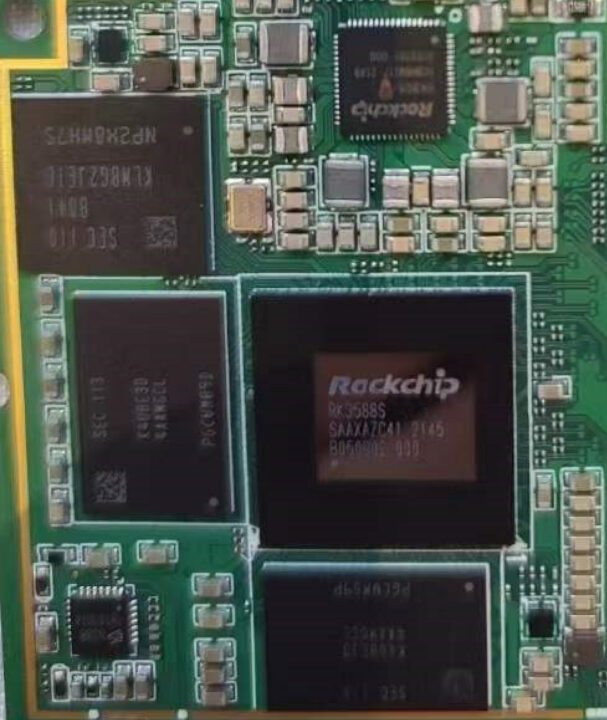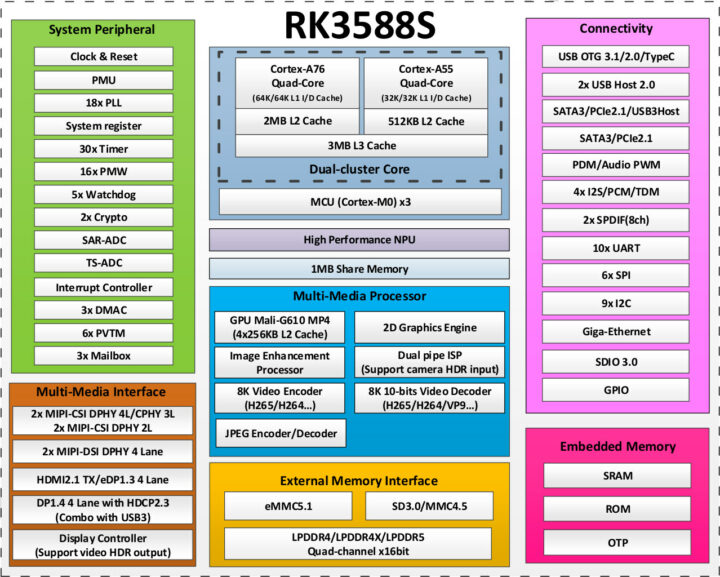Rockchip RK3588S is a cost-optimized version of the RK3588 octa-core Cortex-A76/A55 processor with fewer peripherals, and I’ve been told it’s been designed for tablets, but as we’ll see below, the processor will probably find its way into many other applications.
We first saw RK3588S during the Rockchip Developer Event last December, but at the time we did not have any information, except it would be a lower-cost version. I’ve now received an RK3588S datasheet, so let’s have a look at the block diagram and specifications to find out what’s different.
Rockchip RK3588S specifications with highlights in bold showing the differences against RK3588:
- CPU – 4x Cortex-A76 and 4x Cortex-A55 cores in dynamIQ configuration
- GPU
- Arm Mali-G610 MP4 “Odin” GPU with support for OpenGLES 1.1, 2.0, and 3.2, OpenCL up to 2.2 and Vulkan1.2
- 2D graphics engine up to 8192×8192 source, 4096×4096 destination
- AI Accelerator – 6 TOPS NPU 3.0 (Neural Processing Unit)
- VPU
- Video decoding
- 8Kp60 H.265, VP9, AVS2
- 8Kp30 H.264 AVC/MVC
- 4Kp60 AV1
- 1080p60 MPEG-2/-1, VC-1, VP8
- Real-time 8Kp30 encoding with H.265/H.264; multi-channel encoding supported at lower resolutions
- Video decoding
- Memory I/F – LPDDR4/LPDDR4x/LPDDR5 up to 32GB
- Storage – eMMC 5.1, SD/MMC, 1x SATA 3.0 (multiplexed with PCIe 2.0), FSPI (Flexible SPI)
- Video Output
2x1x HDMI 2.1 / eDP 1.3 up to 8Kp60 (Note: 1x in block diagram, but 2x HDMI/eDP are listed in the datasheet)2x1x DisplayPort 1.4a up to 8Kp30 (multiplexed with USB 3.0)- 2x MIPI DSI output up to 4Kp60
- Bt.1120 video output up to 1080p60
- Not listed in RK3588S datasheet, but I don’t see why not: Optional dual LVDS up to 1080p60 via RK628 chip.
- Up to four independent displays (up to 1x 8Kp60, 2x 4Kp60, 1x 1080p60)
- Video Input/Camera
- 48MP (2x 24MP) ISP with HDR and 3D NR support; multi-camera input
- 2x MIPI DC (4-lane DPHY v2.0 or 3-lane CPHY V1.1)
- 4x 2-lane MIPI CSI
- DVP camera interface
HDMI Rx 2.0 interface up to 4Kp60 with HDCP 2.3 support(Note: removed from the block diagram, but still listed in the datasheet)
- Audio
- 2x 8-channel I2S, 2x 2-channel I2S
- 2x SPDIF
- 2x 8-channel PDM (for mic arrays)
- 2-channel digital audio codec (16-bit DAC)
- VAD engine
- Networking –
Dual1x Gigabit Ethernet - USB –
2x1x USB 3.1 Gen 1 OTG up to 5 Gbps (multiplexed with DisplayPort), 1x USB 3.1 Gen 1 host (multiplexed with Combo “PIPE PHY2”), 2x USB 2.0 HostOTG
PCIe – PCIe 3.0 up to 8 Gbps (1x 4-lane, or 2x 2-lane, or 4x 1-lane, or 1x 2-lane + 2x 1-lane3x2x Combo PIPE PHY interfaces- Combo PIPE PHY0 – SATA III or PCIe 2.1 up to 5 Gbps
- Combo PIPE PHY2 – SATA III, PCIe 2.1, or USB 3.1 Gen1
- Low-speed I/O – 5x SPI, 9x I2C, 10x UART, GPIOs, 12-bit ADC (SARADC), 3x CAN bus
- Package – FCCSP1253L; 17 x 17 mm (RK3588: FCBGA1088L; 21.45 x 21.45mm)
- Manufacturing process – 8nm LP

There are also some smaller changes with more PLL (18x vs 10x) and one extra PVTM brings the total to 6, and three Mailboxes instead of just one. The most notable changes are the removal of the PCIe 3.0 interface, the addition of three CAN bus, and a smaller number of video output/input, Ethernet, USB, and PIPE PHY interfaces.
Depending on the price difference against RK3588, Rockchip RK3588S may end becoming more popular since I’d expect many projects will not make full use of all RK3588 interfaces. If I look at ROCK5 Model B SBC specifications as an example, RK3588S would not be suitable since the board makes use of the PCIe 3.0 interface for NVMe storage, comes with two HDMI 2.1 ports, micro HDMI input, and all USB interfaces from RK3588 without a USB hub chip. But I could easily imagine a lower-cost ROCK5 Model A with slower PCIe 2.1 NVMe storage, one HDMI port, one DisplayPort, no HDMI input, and one less USB 3.0 port, or in other words equipped with four USB ports.
Check out the datasheet for the full details (some of which may be conflicting, as we’ve seen in the specs).

Jean-Luc started CNX Software in 2010 as a part-time endeavor, before quitting his job as a software engineering manager, and starting to write daily news, and reviews full time later in 2011.
Support CNX Software! Donate via cryptocurrencies, become a Patron on Patreon, or purchase goods on Amazon or Aliexpress





